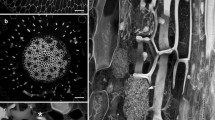Summary
The development of wall ingrowths in leaf blade epidermal cells of the marine angiospermZostera capensis was studied by electron microscopy. Prior to the appearance of ingrowths long profiles of endoplasmic reticulum cisternae become arranged peripherally closely following the contours of the walls. The plasmalemma assumes a wavy appearance and in regions where wall ingrowths first start forming (i.e., along the radial, inner tangential and transverse walls) the plasmalemma becomes separated from the walls by an undulating extracytoplasmic space. Small, irregular projections of secondary wall material make their appearance here. Paramural bodies, dictyosomes, endoplasmic reticulum (ER) and possibly also microtubules seem to be closely associated with the initiation and subsequent development of wall projections. As the cells mature, new ingrowths arise in a centrifugal direction along the radial and transverse walls. When wall ingrowths reach a certain stage of their development, mitochondria become strongly polarized towards them and become closely associated with the plasmalemma which ensheaths the ingrowths. There is often also a close association between ER cisternae and the involuted plasmalemma of the wall projections. Initially ingrowths are slender, curved structures, but become more complex as the cells mature. Ingrowths are most extensively developed along the inner tangential and transverse walls. As epidermal cells age there is a loss of wall material from the ingrowths. The probable significance of the formation of wall ingrowths in the epidermal cells is also discussed.
Similar content being viewed by others
References
Barnabas, A. D., Butler, V., Steinke, T. D., 1977:Zostera capensis Setchell. I. Observations on the fine structure of the leaf epidermis. Z. Pflanzenphysiol.85, 417–427.
—,Guillard, V., 1979: Observations on the fine structure of phloem parenchyma cells in the leaves ofZostera capensis Setchell. Proc. Electron Microscopy Soc. South. Afr.9, 63–64.
Briarty, L. G., 1978: The development of root nodule xylem transfer cells inTrifolium repens. J. exp. Bot.29, 735–747.
Fineran, B. A., 1980: Ontogeny of external glands in the bladderwortUtricularia monanthos. Protoplasma105, 9–25.
Giddings, T. H., Brower, D. L., Staehelin, L. A., 1980: Visualization of particle complexes in the plasmamembrane ofMicrasterias denticulata associated with the formation of cellulose fibrils in primary and secondary cell walls. J. Cell Biol.84, 327–339.
Gori, P., 1977: Wall ingrowths in the embryo sac ofEuphorbia helioscopia. Israel J. Bot.26, 202–208.
Gunning, B. E. S., Pate, J. S., 1969: “Transfer Cells”. Plant cells with wall ingrowths, specialized in relation to short distance transport of solutes — their occurrence, structure, and development. Protoplasma68, 107–133.
Harlin, M. M., 1973: Transfer of products between epiphytic marine algae and host plants. J. Phycol.9, 243–248.
Huang, C. S., Maggenti, A. R., 1969: Wall modifications in developing giant cells ofVicia faba andCucumis sativus induced by root knot nematode,Meloidogyne javanica. Phytopathology59, 931–937.
Jones, M. G. K., Northcote, D. H., 1972: Nematode induced syncytium — a multinucleate transfer cell. J. Cell Sci.10, 789–809.
Marchant, R., Robards, A. W., 1968: Membrane systems associated with the plasmalemma of plant cells. Ann. Bot.32, 457–471.
McRoy, C. P., Barsdate, R. J., Nebert, M., 1972: Phosphorus cycling in an eelgrass (Zostera marina L.) ecosystem. Limnol. Oceanogr.17, 58–67.
Mueller, S. C., Brown, R. M., 1980: Evidence for an intramembrane component associated with a cellulose microfibril-synthesizing complex in higher plants. J. Cell. Biol.84, 315–326.
Newcomb, W., Peterson, R. L., 1979: The occurrence and ontogeny of transfer cells associated with lateral roots and root nodules inLeguminosae. Canad. J. Bot.57, 2583–2602.
Peterson, R. L., Yeung, E. C., 1975: Ontogeny of phloem transfer cells inHieracium floribundum. Canad. J. Bot.53, 2745–2758.
Pickett-Heaps, J. D., 1968: Xylem wall deposition. Radioautographic investigations using lignin precursors. Protoplasma65, 181–205.
Robards, A. W., Kidwai, P., 1969: Cytochemical localization of phosphatase in differentiating secondary vascular cells. Planta87, 227–238.
Roland, J. C., 1973: The relationship between the plasmalemma and the plant cell wall. Int. Rev. Cytol.36, 45–92.
Schnepf, E., 1974: Microtubules and cell wall formation. Portugal. Acta Biol. Ser. A14, 451–461.
—,Pross, E., 1976: Differentiation and redifferentiation of a transfer cell: Development of septal nectaries ofAloe andGasteria. Protoplasma89, 105–115.
Tu, J. C., Hiruki, C., 1971: Electron microscopy of cell wall thickening in local lesions of potato-virus-M-infected red kidney bean. Phytopathology61, 862–868.
Westafer, J. M., Brown, R. M., 1976: Electron microscopy of the cotton fiber: new observations on cell wall formation. Cytobios.15, 111–138.
Yeung, E. C., Clutter, M. E., 1979: Embryogeny ofPhaseolus coccineus: the ultrastructure and development of the suspensor. Canad. J. Bot.57, 120–136.
—,Peterson, R. L., 1974: Ontogeny of xylem transfer cells inHieracium floribundum. Protoplasma80, 155–174.
— —, 1975: Fine structure during ontogeny of xylem transfer cells in the rhizome ofHieracium floribundum. Canad. J. Bot.53, 432–438.
Author information
Authors and Affiliations
Rights and permissions
About this article
Cite this article
Barnabas, A.D., Butler, V. & Steinke, T.D. Zostera capensis setchell: III. Some aspects of wall ingrowth development in leaf blade epidermal cells. Protoplasma 110, 87–94 (1982). https://doi.org/10.1007/BF01281534
Received:
Accepted:
Issue Date:
DOI: https://doi.org/10.1007/BF01281534




